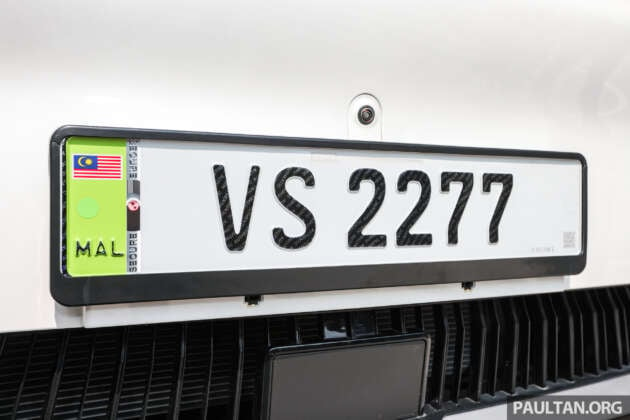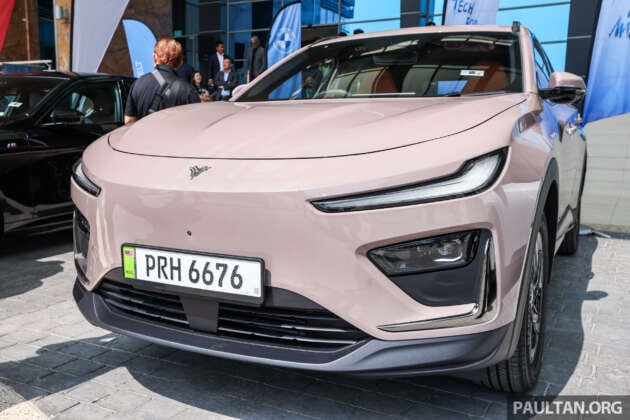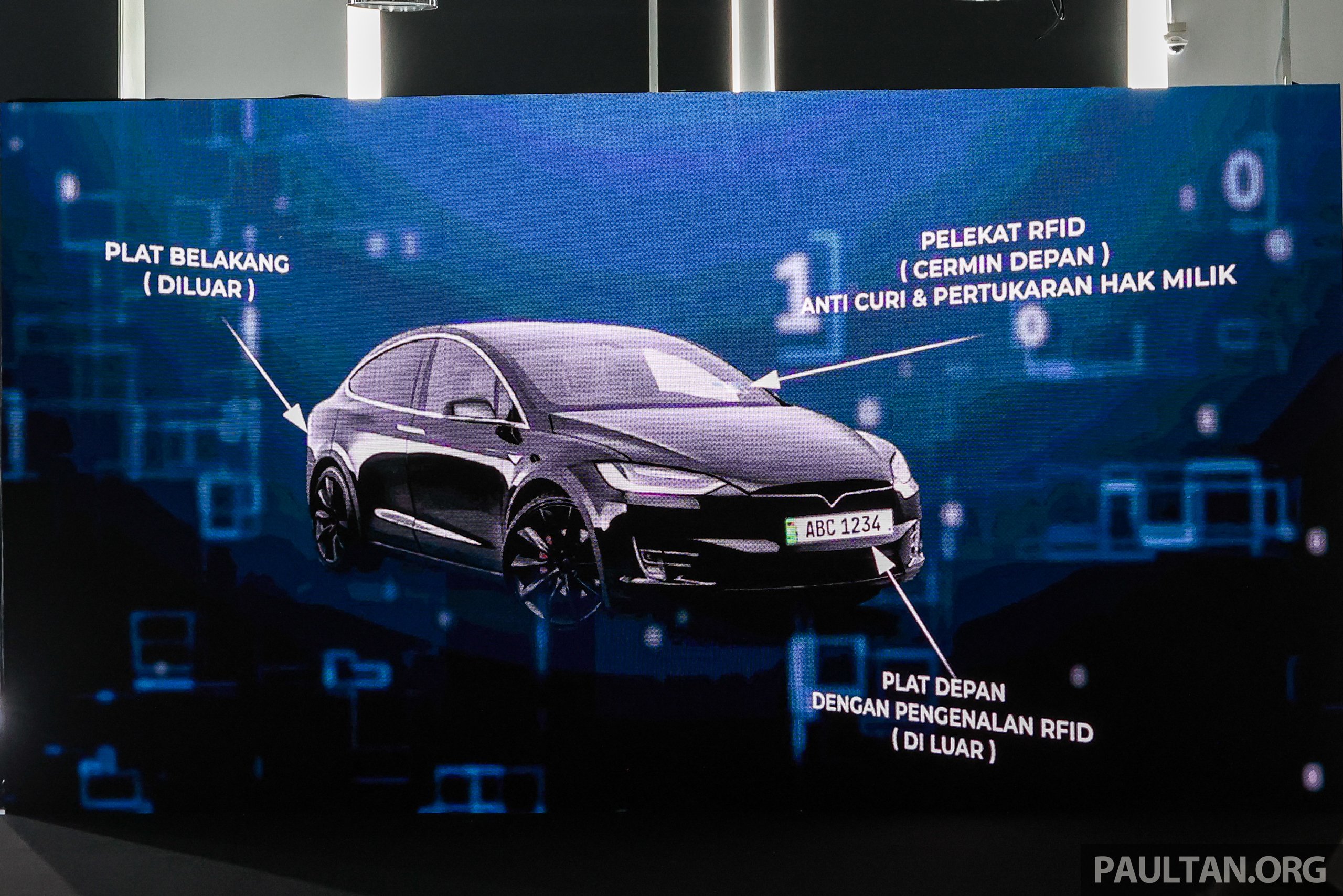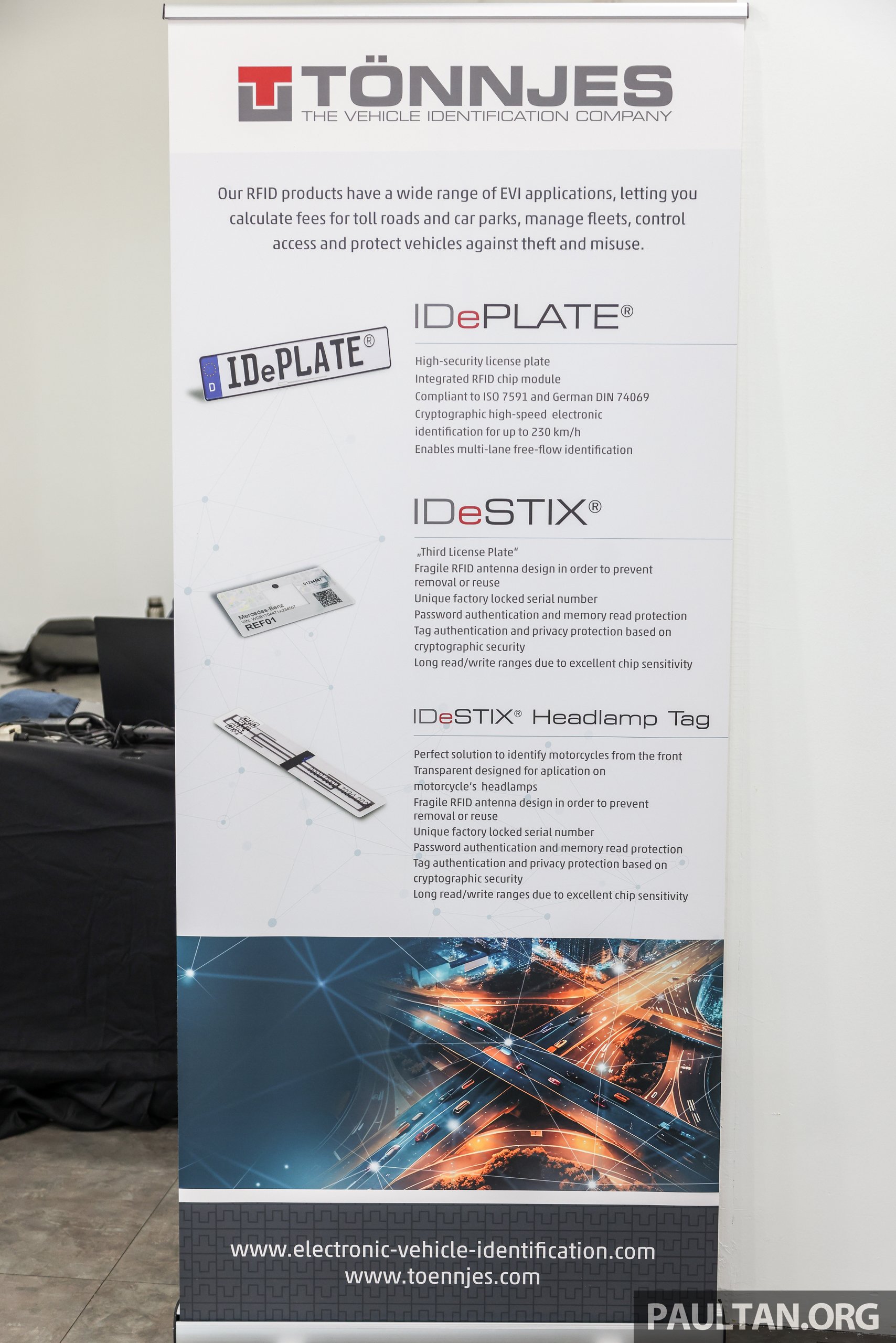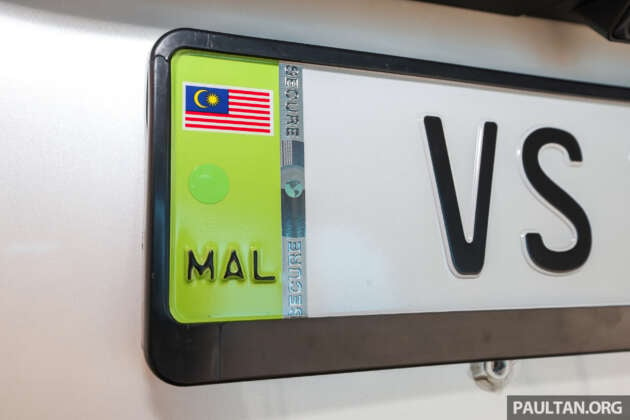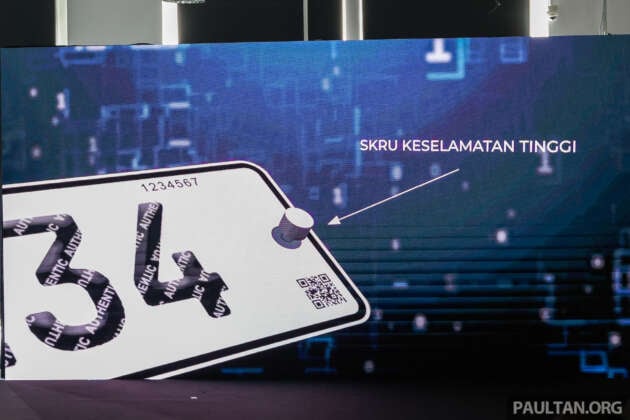The transport ministry has introduced the new special licence plate (RPK, or rekaan plat khas) specifically for electric vehicles, with transport minister Anthony Loke officially introducing the JPJePlate in Cyberjaya earlier this morning.
The new JPJePlate is not an EV number plate series (as in ‘EV 1’ to ‘EV 9999’) but rather a specific licence plate design, different to the standard simple white lettering (alphabets and numbers) mounted on a black background in use at present.
Coincidentally, the ministry also announced the introduction of the “EV” series number plates, specifically for fully-electric vehicles. Bidding opened today and ends on September 13.
Independent of that, number plates under the current vehicle registration system (for example, V prefix for WP, B for Selangor etc) can be used with the JPJePlate, but it has to be for an EV. Most importantly, the presentation format for the plate is different, as highlighted during a special briefing on it by the ministry a while back.
Euro-style
How so? Well, as can be seen in the images, the new RPK features a new font. That’s because it does not have lettering affixed to it, instead being embossed on the plate, which is constructed of aluminium. The background and lettering for the plate is in reverse to the existing plate system, with a white background (which is reflective) and lettering (which has an anti-counterfeit hologram) in black.
On the left hand side of the plate, you’ll find a colour notation, along with the Malaysian flag and country code identifier, demarcated by a holographic security strip. Green is the colour chosen to denote EVs, and while it was not mentioned, other colours will likely come into play well into the future.
If you’re thinking the design element looks very European, well, that’s because it is. The RPK, measuring 11 cm tall and 52 cm wide, is sourced from Tonnjes, a German company specialising in vehicle identification.
It’s an IDePlate with a QR code and an integrated RAIN (RAdio frequency IdentificatioN) passive RFID chip running a GS1 UHF Gen2 protocol, operating in the 860 MHz to 930 MHz UHF range. The RFID element isn’t in play yet, but future-proofs the plate for intelligent transportation system (ITS) integration down the line as well for possible payment options.
Why have a new plate?
According to the ministry, the idea behind introducing the new plate design in what is essentially a pilot project for it is to easily differentiate new emissions-free vehicles from internal combustion engined ones.
In the first phase, its use is purely only for battery-electric (all-electric) vehicles, as hybrids, PHEVs or ICE vehicles will not have access to it. The ministry said that having the plate on EVs will aid fire/emergency services in identifying the nature of the vehicle, ensuring an appropriate response in accidents.
Who will/can use this special EV plate?
As stated earlier, the JPJePlate can only be used for fully-electric vehicles, and it is optional for EV owners for now. The ideo is of course to eventually have the EV-specific plate be made mandatory for all new EVs registered in the country, but much will depend on the pilot project and response to the plate.
As of today, September 9, 2024, the JPePlate is available for booking on the road transport department’s (JPJ) jpjeplate.jpj.gov.my website.
As of now, registrations for new EV plates are only through the various OEM car companies retailing Evs or business partners appointed for it, with applications being made online via a dedicated RPK portal or app.
Additionally, owners of existing EVs that have already been registered will have the option of switching to the JPJePlate for their vehicle starting from November, with registration of interest already open for it.
First step towards standardised plates for all new cars in the future?
That’s the general idea, but this will be well down the road. At the briefing, the ministry revealed that Malaysia is among 5% of the countries left using traditional plates globally, and it is looking to gradually move away from that.
The initiative to introduce the new plate is aimed at exploring the eventual standardisation of the licence plate for all new vehicles registered in Malaysia, effectively eliminating fancy/non-regulation plates and reducing vehicle cloning opportunities, among other things.
If it gets to the point that adoption becomes uniform across all powertrain types, all new vehicle registrations will one day utilise the JPJeplate, or so goes the plan. However, it doesn’t mean that the RPK is mandatory for every vehicle that has been registered and is still running on the road. According to the ministry, legacy – as in existing – vehicles will be able to continue using the current plate format, meaning owners of these won’t have to fork out extra.
How much for it, and what do you get?
As you’d expect, there is cost involved. The JPJePlate is priced at RM98, and for that outlay, you get a front (RFID-equipped) and rear aluminium plate as well as a third licence plate in the form of a security sticker attached to the windshield.
Also containing a RAIN RFID chip and a QR code, the IDeStix has the same functionality as the front plate, offering a further layer of identification security – it is non-removable, and will be destroyed should there be an attempt to remove it.
Handal Ceria is the local vendor appointed to issue the plate, so the entire process of stamping and delivery of the JPJePlate goes through it in the pilot phase.As of now, registrations for new EV plates are only through the various OEM car companies retailing Evs or business partners appointed for it, with applications being made online via a dedicated RPK portal or app.
Once the application is processed, the company states that plate can be delivered in the following ways:
- Standard delivery – one to two days for Peninsular Malaysia, three to four days for East Malaysia (no extra charge, included in cost of plate).
- Express on demand delivery – orders made before 10am will be sent out on the same day (additional cost, depending on distance).
- Self-collection – from the Handal Ceria office in Cyberjaya.
At the briefing, it was stated that the best time to submit applications for registration numbers that are already on hand should be five days before delivery of the vehicle to the customer. For running numbers, applications can be made once the eDaftar is done, using the provisional registration.
Installation process
Affixing the JPJePlate, including the windshield sticker, is carried out by the vehicle retailer or business partner (which means self-collection, if chosen, has to be carried out by the latter’s designated staff).
Two types of fitment have been approved for the installation of the RPK. The proposed one is to have the plates attached to the vehicle with security screws to the bumper or the plate holder base – this, Handal Ceria said, is the recommended choice in ensuring the highest level of security against theft, because it would make the plate difficult to remove.
The other is of course the traditional route, of using a 52 x 11 cm plate holder that the RPK can be inserted into. This leeway for attachment is being given because feedback has indicated that some vehicle owners fear some damage from the install, but really, there’s nothing a good screw can’t solve. It’s not hard to imagine that given their novelty, at least in the immediate future, quite a number of RPKs could well be liberated in cars parked in unattended locations.
Once fixed on the vehicle, images have to be taken of the fitment (front, rear and windscreen) and uploaded to the registration section of the RPK online portal/app. This is to ensure that the fitment is accomplished and carried out correctly. The company said the approval process subsequent to the image submission will not take long.
Regarding a replacement RPK should the vehicle be damaged in an accident and require a new unit, the application process for the replacement is the same as per new registrations.
So, there you have it, the lowdown on the new JPJePlate for EVs. What do you think of the RPK? Do you like the direction being taken, or do you still prefer the current vehicle registration plate design?
Looking to sell your car? Sell it with Carro.
Content Disclaimer and Copyright Notice
Content Disclaimer
The content provided on this website is sourced from various RSS feeds and other publicly available sources. We strive to ensure the accuracy and reliability of the information, and we always provide source links to the original content. However, we are not responsible for the content’s accuracy or any changes made to the original sources after the information is aggregated on our site.
Fair Use and Copyright Notice
This website may contain copyrighted material, the use of which has not always been specifically authorized by the copyright owner. We believe this constitutes a “fair use” of any such copyrighted material as provided for in section 107 of the US Copyright Law.
In accordance with Title 17 U.S.C. Section 107, the material on this site is distributed without profit to those who have expressed a prior interest in receiving the included information for research and educational purposes. If you wish to use copyrighted material from this site for purposes of your own that go beyond fair use, you must obtain permission from the copyright owner.

